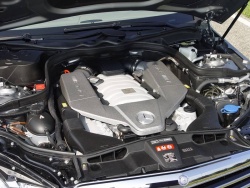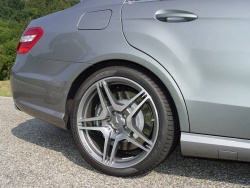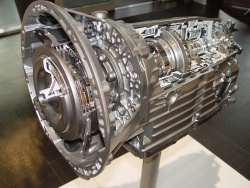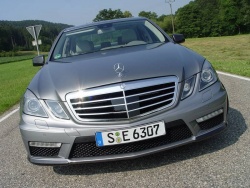AMG engineers do have to be commended for improving this engine’s fuel economy while increasing horsepower slightly to 518 hp at 6,800 r.p.m. and maintaining peak torque at 465 lb-ft at 5,200 r.p.m. The E63’s arch competitors, the V10-powered BMW M5 and Audi S6, both have less horsepower and torque but use more fuel, according to Natural Resources Canada Energuide ratings.
   2010 Mercedes-Benz E 63 AMG. Click image to enlarge |
As you’re probably aware, Mercedes-Benz’ AMG performance division based in Afalterbach, Germany near Stuttgart, modifies existing Mercedes-Benz models to improve acceleration, handling, steering, braking, and high-speed performance. Each AMG engine is assembled by hand from start to finish by one engineer, who stamps his signature on top of the engine when it’s finished – it takes about three hours and ten minutes to build one 6.2-litre V8. (Note: though Mercedes refers to it as a 6.3-litre V8, it’s displacement of 6208 cc is closer to 6.2 litres). Other modifications done at the small Afalterbach factory include suspension upgrades, improved brakes, revised steering, new wheels and tires, instrument and cabin control upgrades. Custom paint, bodywork and mechanical upgrades can also be accommodated for a price.
What distinguishes the 2010 E63 AMG from the standard 2010 E-Class sedan is its unique 6.2-litre AMG DOHC 32-valve V8 engine, a specially tuned suspension with electronically controlled shock absorbers to reduce roll angle when cornering; a new front axle, new steel spring struts and a 56 mm wider front track to provide more stability when cornering at speed; and rear air springs with automatic levelling to keep the car at a constant height regardless of load. The driver can select three suspension modes: Comfort, Sport and Sport Plus with the touch of a button. These provide progressive levels of firmness and response from softer to harder.
The all-new seven-speed AMG MCT Speedshift transmission, first seen in the SL63, uses a compact, wet start-up clutch instead of the traditional torque converter. Shift times have been reduced to just 100 milliseconds by briefly interrupting ignition and fuel injection operation when shifting. Manual shifts can be accomplished by pulling on the paddles behind the steering wheel (right to shift up, left to shift down), or it can be just left in Automatic mode. The seven-speed Speedshift transmission features four driver-selectable performance modes: Comfort, Sport, Sport + and Race Start. The first three offer progressively more aggressive shifting and downshifting including automatic double de-clutching. Race Start allows the driver to get the maximum acceleration from a standing start without spinning the tires or damaging the transmission. The Speedshift tranny also features a Controlled Efficiency mode that shifts gears early to keep engine speeds and fuel consumption low.
 2010 Mercedes-Benz E 63 AMG. Click image to enlarge |
The 2010 E63 AMG also features new speed-sensitive rack and pinion steering with a ratio of 14:1 and a more rigid steering column that is 22 per cent more direct than in a standard E-Class sedan. I found it extremely accurate and responsive while cornering, stable at very high speeds, but light enough to park at low speeds without much effort.
The new E63 also features a three-stage electronic stability control (ESP) system. The driver can select ESP On, ESP Sport, or ESP Off depending on how much they want the rear end to hang out when cornering. However, with rear-wheel drive, fat rear tires, and 465 pound-feet of torque, I would recommend leaving the ESP on most of the time.











